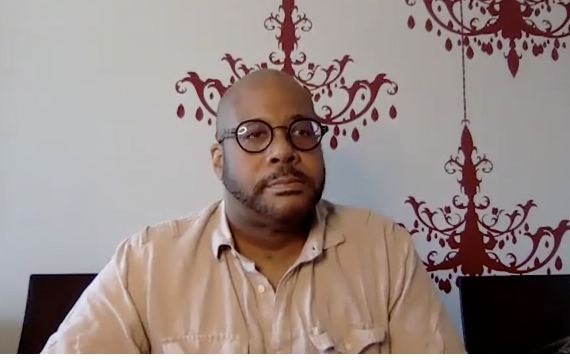Confronting systemic racism and microaggressions in the workplace
How one Black comms pro helped expose a toxic culture—but endured years of anxiety and stress along the way.

A concept of unfair social prejudice. The miniature men and a magnifying glass.
For Jefferson Darrell, it was like an extended nightmare. As a media relations officer in the public sector in Ontario, he experienced a long series of workplace microaggressions—anti-Black racism—that left him stressed and depleted.
Darrell, now the founder of Breakfast Culture, a boutique marketing and communications firm that focuses on diversity and inclusion, calls this Racial Battle Fatigue. It stems from a series of common workplace dynamics, not limited to any single organization or even country. Typically, Darrell said in a recent Ragan Webinar, it includes these things:
- A person of color comes into a job and is initially welcomed by the white leadership. It’s a tokenized hire.
- The same person begins to experience a raft of microaggressions. Repetitive injury. She works within the organization’s structure to push for accountability.
- The organization denies systemic racism. It ignores the aggrieved employee. Or blames her. It places the responsibility of fixing the problem on the employee herself, and her black and brown colleagues.
- The organization decides the person of color is the problem. It characterizes the conflict as a “communications” issue, or claims that the employee isn’t a good fit.
- The person of color exits the organization.

This, Darrell suggests, is the reality in many organizations. It was for him. In one organization, he says, he was doing director-level work but his title was manager of communications. Darrell and another Black colleague were the only people who had a manager title—the rest were directors.
In another, he recalls, he noticed issues of racism as soon as he was hired fully time. For example, at a meeting on the topic of how to attract more minorities to the organization—a meeting that included only white colleagues—he was told to take the minutes but not to talk. After hearing similar stories, he went to the HR department and suggested developing a strategy for diversity and inclusion. The response was, “Well Jefferson, if you come with a problem, you should also come with a solution.”
His response: My skillset is in marketing and communications, not HR, and that’s why I’m bringing it to you. The HR manager said, “Well, Jefferson, it seems like it’s just you. No one else seems to have these issues.”
Darrell says this is a common response from the powers that be. “Whenever you bring up racism or discrimination in the workplace, the default question is, ‘How do you know?’” Darrell says. “Believe me, we know.”
For Darrell, the pattern continued for years. He describes how Racial Battle Fatigue has serious health consequences. In general, they include physical symptoms, such as headaches, weight gain, high blood pressure, insomnia. They include psychological responses, such as anxiety, depression, defensiveness, helplessness, and irritability. And there are emotional and behavioral responses as well, such as memory and concentration issues.
Darrell had some of these symptoms. “During this whole time, personally I felt suicidal,” Darrell says. “I felt helpless. During these years I would wake up at 2:00 a.m., 3:00 a.m. on Monday mornings, dreading going to work. I’m still having feelings of anger. I’m still having feelings of being an imposter.”
Ultimately, Darrell’s experiences were validated in a report by Ontario Public Service, which includes 60,000 Ontario provincial employees. The 175-page report details how Black employees work in a “culture of fear” of their white managers and co-workers, who face little to no consequences for bad behavior. It found a pattern of discrimination and harassment that was “persistent and unyielding.”
The report indicated a gap in what the OPS claims to value and the actual experiences of its Black employees, the report said. “We heard Black employees express their overwhelming feelings of powerlessness in the face of what many described as White indifference.”
Darrell’s reaction to the report was mixed. “When the CBC article came out those who questioned me were placated,” he says. “This is something that really does bother me. I am generalizing here, but as a society we rarely believe people who voice their experiences of discrimination or marginalization. Often it is only accepted when—and I am going to be crass here—a straight white man says it is so.”
A fellow presenter on the Ragan webinar, Karla Lever, director of the employee assistance program at Charlotte, North Carolina-based Atrium Health, offered a series of tips for organizations to improve how they approach the kinds of situations that Darrell experienced. “Each person is a brilliantly colored thread in the tapestry of humankind and we need each one for the tapestry to be whole, beautiful and complete,” Lever says.

Start with a careful look at diversity in the organization. If there’s a lack of diversity in any department, think about the reasons. “Having a homogenous group of workers will limit creativity and stifle growth,” she says. “Embrace that idea and recognize and celebrate people’s differences and ideas.”
Then consider why you may gravitate more towards some employees than others. Sometimes differences are uncomfortable, but growth rarely comes without at minimum, some discomfort, Lever says. Also:
- Ask employees anonymously how the workplace could be more inclusive.
- Ask what you and the organization are doing well in this area and how it could be improved.
- Work to not take the responses personally, but to see them as areas for growth.
- Embrace the willingness to be vulnerable.
- Make sure you set clear and high expectations about workplace inclusiveness and speak to employees immediately if they fall short of the expectation.
- Do not allow disrespectful behaviors to continue—take serious action.
- Admit openly when you fall short and apologize publicly.
- Have employees engage in training that celebrates diversity and inclusion.
“Remember to enjoy your fellow employees,” Lever says. “We spend more time at work than anywhere else and it is up to each one of us to make our culture cohesive and enjoyable.”
COMMENT
Ragan.com Daily Headlines
RECOMMENDED READING
Tags: Anti-Black racism, Atrium Health, Breakfast culture, diversity and inclusion, Jefferson Darrell, Karla Lever, mental health, Ontario Public Service






